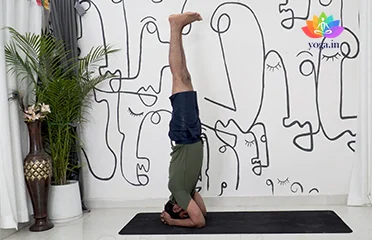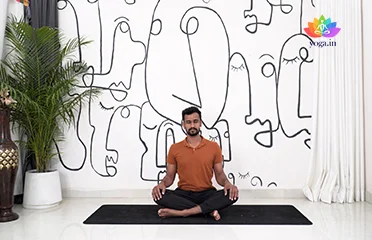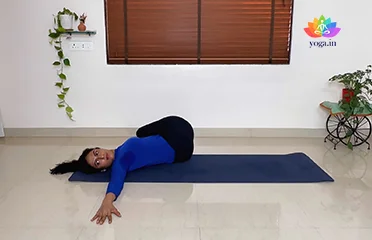Sarvangasana (Shoulderstand)
सर्वाङ्गासनI / Shoulderstand
The Sanskrit name is derived from Sarva (सर्वाङ्ग) meaning all, [�K]
Shalabhasana (Locust Pose)
सलभासन / Locust Pose
The Sanskrit name is derived from Shalabha (शलभा) meaning locust and [�K]
Sirsasana (Headstand)
शीर्षासन / Headstand
The Sanskrit name is derived from Sirsa (शीर्ष) meaning head and asana [�K]
Sukhasana (Easy Pose)
सुखासनम् / Easy Pose
The Sanskrit name is derived from Sukh (सुख) means anand/ aaram and asana [�K]
Supta Matsyendrasana (Supine Spinal Twis
सुप्त मत्स्येन्द्रासन / Supine Spinal Twist Pose
The Sanskrit name is derived from Supta (सुप्त) means supine, Matsya [�K]
- 1
- 2
How Yoga Can Help Cure Lower Back Pain:
Lower back pain is a prevalent discomfort that can range from mild to severe, affecting daily activities and quality of life. Yoga offers effective methods to manage and alleviate lower back pain by strengthening core muscles, improving flexibility, and promoting relaxation.
Understanding Lower Back Pain:
Lower back pain refers to discomfort or pain in the lumbar region of the spine, often caused by muscle strain, injury, or poor posture. It can vary in intensity and duration, impacting mobility and overall well-being.
Yoga’s Role in Relieving Lower Back Pain:
Yoga provides a holistic approach to relieving lower back pain by addressing physical, mental, and emotional aspects. Specific yoga poses, such as gentle stretches and strengthening exercises, target the muscles surrounding the spine, improving flexibility and reducing tension. Additionally, breathing techniques and relaxation practices help alleviate stress and promote a sense of calm, which can further alleviate lower back pain.
Key Factors Contributing to Lower Back Pain:
Various factors can contribute to lower back pain, including:
- Muscle Strain: Overuse or improper lifting techniques can strain the muscles of the lower back.
- Poor Posture: Slouching or sitting for extended periods can strain the spine and muscles.
- Injury: Accidents, falls, or sudden movements can cause injuries to the back.
- Obesity: Excess weight puts pressure on the spine and can contribute to lower back pain.
- Sedentary Lifestyle: Lack of physical activity weakens muscles and increases the risk of back pain.
Symptoms of Lower Back Pain:
Common symptoms associated with lower back pain include:
- Dull Ache: Persistent discomfort or pain in the lower back.
- Stiffness: Difficulty moving or bending the lower back.
- Radiating Pain: Pain that extends from the lower back down the legs (sciatica).
- Muscle Spasms: Sudden, involuntary contractions of the back muscles.
- Limited Mobility: Difficulty standing, walking, or performing daily activities.
Treatment of Lower Back Pain through Yoga and Pranayama:
Yoga offers effective techniques to manage lower back pain and promote healing. Some beneficial practices include:
Specific Yoga Poses:
- Cat-Cow Stretch: Improves spinal flexibility and relieves tension.
- Child’s Pose (Balasana): Stretches the lower back and promotes relaxation.
Pranayama Exercises:
Deep Belly Breathing: Relaxes the muscles of the lower back and reduces tension.
Diet for Lower Back Pain:
A balanced diet rich in nutrients can support overall health and alleviate lower back pain. Recommendations include:
- Anti-Inflammatory Foods: Incorporate foods rich in omega-3 fatty acids, such as salmon, flaxseeds, and walnuts.
- Hydration: Drink plenty of water to keep the spinal discs hydrated and flexible.
- Calcium and Vitamin D: Consume dairy products, leafy greens, and fortified foods to support bone health.
- Fruits and Vegetables: Choose a variety of colorful fruits and vegetables for their antioxidant properties.
Caution for Lower Back Pain:
While practicing yoga for lower back pain, it is essential to:
- Listen to Your Body: Avoid pushing into poses that cause pain or discomfort.
- Modify Poses: Use props or modify poses to suit your level of flexibility and comfort.
- Consult a Healthcare Professional: If you have severe or chronic lower back pain, consult a healthcare provider before starting any new exercise regimen.
Contraindications for Lower Back Pain:
Individuals with severe lower back pain or specific spinal conditions should:
- Avoid High-Impact Activities: Vigorous yoga practices or exercises that strain the lower back.
- Avoid Forward Bending: Poses that involve deep forward bends may exacerbate lower back pain.
- Seek Professional Guidance: Consult a yoga instructor or physical therapist for personalized guidance and modifications.






